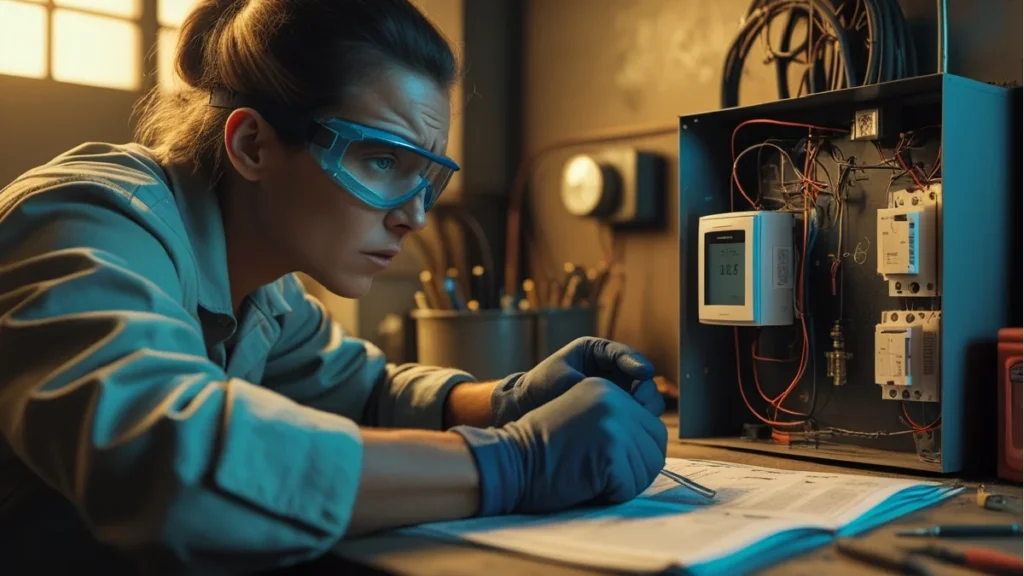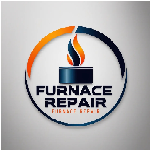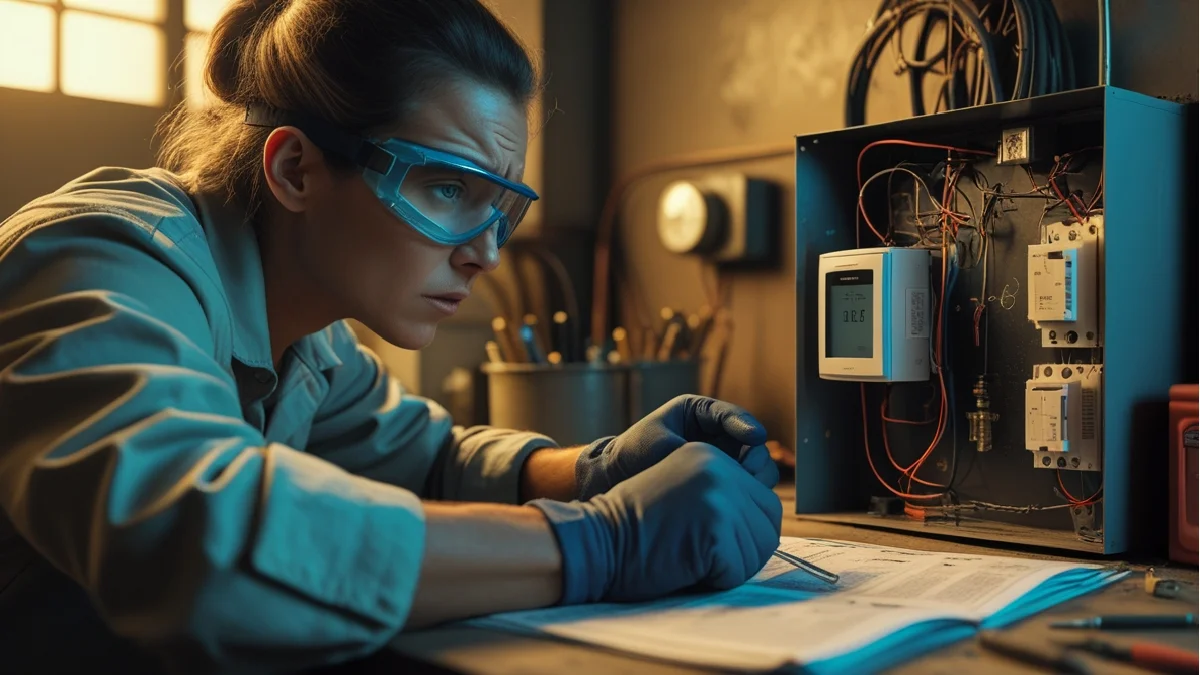Introduction to Troubleshooting Electric Furnace Thermostats
When your home feels chilly and the furnace won’t cooperate, the thermostat is one of the first things to check. For U.S.

homeowners, troubleshooting electric furnace thermostats can quickly restore comfort, save on unnecessary service calls, and help you decide when it’s time to bring in a pro.
This step-by-step guide uses plain language, U.S. terms, and safe, practical steps you can follow with basic tools.
Safety first: If you’re unsure about anything—especially when working around electricity—stop and call a licensed HVAC technician.
How Electric Furnace Thermostats Work
Most central electric furnaces in American homes use a 24-volt (low-voltage) thermostat. Here’s the simple chain of events:
- The thermostat measures room temperature and compares it to your setpoint.
- When heat is needed, it sends a 24V “call for heat” signal from R (power) to W (heat).
- The furnace energizes its heating elements and then starts the blower to distribute warm air.
What to know:
- Low-voltage vs. line-voltage: Central systems typically use 24V wiring (thin wires labeled R, W, C, G, Y). Some electric baseboard or wall heaters use line-voltage thermostats at 120/240V with thicker wires. Identify what you have before any work.
- Common terminals: R (24V power), C (common), W (heat), G (fan), Y (cool/heat pump). Heat-only systems may have just R and W, with C optional.
- Smart thermostats: Many U.S. smart models require a C wire for continuous power. If your system doesn’t have C, you may need a power extender kit or a model that works without C.
Common Signs of a Faulty Thermostat
- Furnace won’t turn on even with Heat mode selected and the temperature set several degrees higher than room temp.
- Short cycling (turns on and off quickly).
- Display is blank, flickers, or frequently loses Wi‑Fi connection.
- Room feels much cooler than the thermostat reading.
- Fan runs constantly in Heat mode or won’t run at all.
- You have to set unusually high temperatures (e.g., 78–80°F) to feel warm.
Step-by-Step Troubleshooting Guide troubleshooting electric furnace thermostats
Before touching any wires, switch off the furnace breaker. If you discover a line-voltage (120/240V) thermostat, do not proceed—call a licensed HVAC technician.
Step 1: Check the Power Supply (troubleshooting electric furnace thermostats)
- Verify breakers: At your electrical panel, make sure the furnace breaker is on and not tripped. Reset once if needed.
- Service switch: Many furnaces have a nearby service switch that looks like a light switch. Confirm it’s on.
- Door switch: Some units cut power when the blower door is removed. Ensure the panel is fully seated.
- Control-board fuse: Look for a small blade fuse (3A/5A) on the control board. If it’s blown, replace it once; if it blows again, there’s an underlying issue.
- 24V presence (experienced users only): Using a multimeter, check for ~24 VAC between R and C at the control board. No 24V can indicate a bad transformer, blown fuse, or open safety circuit.
If power is absent or you’re not comfortable testing, it’s time to call a pro.
Step 2: Inspect the Thermostat Settings troubleshooting electric furnace thermostats
- Mode and setpoint: Set to Heat and raise the setpoint 3–5°F above the displayed room temperature.
- Fan setting: Use Auto for normal heating. Fan On forces continuous blower operation.
- Schedule/hold: Apply a temporary Hold to rule out a conflicting programmed schedule.
- Batteries: If your thermostat uses batteries, replace them with fresh, high-quality alkaline batteries.
- Placement: Drafts, direct sunlight, lamps, or electronics near the thermostat can skew readings.
Step 3: Test the Wiring Connections for Troubleshooting Electric Furnace Thermostats
- Power off: Turn off the breaker before touching any wires.
- Inspect connections: Remove the thermostat faceplate. Confirm each wire is firmly secured and correctly landed (R to R, W to W, C to C if present). Give each wire a gentle tug.
- Check wire condition: Look for corrosion, loose strands, or damaged insulation.
- Isolate the fault (low-voltage only, optional, and only if you’re confident):
- Restore power, then at the furnace control board briefly jumper R to W.
- If the furnace runs, the thermostat or its cable run may be at fault.
- If nothing happens, the issue is likely within the furnace or safety circuits.
- Power off again and remove the jumper after testing.
- Line-voltage systems: Do not attempt live testing—call a licensed technician.
Step 4: Calibrate or Reset the Thermostat
- Temperature offset: Compare the thermostat reading to a reliable room thermometer. If it’s off by 2–5°F, adjust the offset/calibration in the settings.
- Firmware: For Wi‑Fi thermostats, update via the app to fix sensor or control glitches.
- Factory reset: If behavior is erratic, perform a factory reset, then reconfigure the system type (conventional heat, electric furnace, number of stages). Follow the manufacturer’s U.S. installation guide.
Step 5: Replace the Thermostat if Necessary
- Match the system: Choose a thermostat compatible with an electric furnace (single-stage is common; some systems support multi-stage).
- C-wire check: If you want a smart thermostat, confirm you have a C wire or plan for a power extender kit.
- Safe install basics:
- Turn power off at the breaker.
- Label wires and take a photo before removal.
- Mount the new base, connect wires to the correct terminals, and secure the faceplate.
- Setup and test: Run the thermostat’s equipment tests to confirm the furnace responds to a call for heat.
Tools You’ll Need for Troubleshooting
- Non-contact voltage tester
- Digital multimeter (for 24V checks, if experienced)
- Small flathead and Phillips screwdrivers
- Needle-nose pliers and wire labels or masking tape
- Fresh AA/AAA batteries (if applicable)
- Room thermometer
- Flashlight or headlamp
- Spare 3A/5A blade fuse (if your control board uses one)
- Your thermostat’s manual or app
When to Call a Professional HVAC Technician
- You’re unsure whether you have low-voltage (24V) or line-voltage (120/240V) wiring.
- Breakers trip repeatedly, you see burnt insulation, or you smell overheating.
- There’s no 24V between R and C after checking the fuse and transformer.
- The furnace runs when R and W are jumpered at the board, but not with any thermostat you try.
- You’re uncomfortable performing electrical tests or removing access panels.
- You’re installing a smart thermostat and don’t have a C wire or clear compatibility.
Typical U.S. service-call fees range from about 100–100–250 before parts, depending on region and time of day.
Preventive Maintenance Tips
- Replace or clean furnace filters regularly (often every 1–3 months) to avoid overheating and short cycling.
- Keep the thermostat away from drafts, heat sources, and direct sun to maintain accurate readings.
- Dust the thermostat gently and keep supply and return vents unobstructed.
- After any maintenance, confirm the furnace door is fully closed and the service switch is on.
- For smart thermostats, keep firmware updated and review schedules at the start of heating season.
- Book an annual fall HVAC tune-up to catch issues before winter.
Conclusion: Troubleshooting Electric Furnace Thermostats
For many American households, troubleshooting electric furnace thermostats starts with simple checks: power, settings, and wiring. From there, calibration, a reset, or a properly matched replacement can solve most thermostat-related heating issues. When in doubt—especially with live voltage—call a licensed HVAC professional to keep your home safe and comfortable.
Questions to Ask About Troubleshooting Electric Furnace Thermostats
- Is my system low-voltage (24V) or line-voltage (120/240V)?
- Did I verify the breaker, service switch, and control-board fuse are good?
- Does the thermostat’s temperature reading match a reliable room thermometer?
- Are any wires loose, mislanded, corroded, or damaged at the thermostat or control board?
- If I jumper R to W at the furnace (24V systems only), does the heat come on?
- Do I need a C wire for the thermostat I want to install?
- Is the thermostat configured for the correct system type (electric furnace, not heat pump)?
- Have I ruled out non-thermostat causes like a clogged filter or tripped high-limit switch?
- Am I comfortable proceeding safely, or should I call a licensed HVAC technician now?
Discover How to Clean Burners on a Gas Furnace safely with our quick guide, and share your experience on facebook.
FAQs
How can I quickly tell if the thermostat or the furnace is the problem?
On a 24V system, briefly jumper R to W at the control board; if the heat starts, the thermostat or its wiring is likely at fault.
Do I need a C wire to install a smart thermostat on an electric furnace?
Most smart thermostats require a C wire; if you don’t have one, use a power extender kit or run a new wire rather than relying on unreliable jumpers.
When should I stop troubleshooting electric furnace thermostats and call a pro?
f breakers trip, you smell burning, see 120/240V line-voltage wiring, or still have no 24V between R and C after checking the fuse, call a licensed HVAC technician.


Leave a Reply